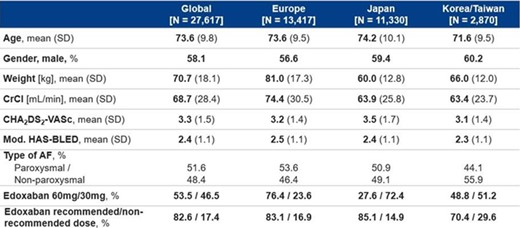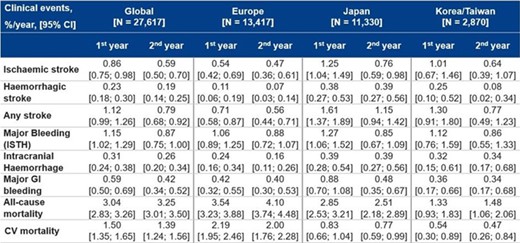-
PDF
- Split View
-
Views
-
Cite
Cite
L Dinshaw, C Chen, R De Caterina, W Jiang, Y.-H Kim, Y Koretsune, D Morrone, L Pecen, P.-E Reimitz, C.-C Wang, T Yamashita, M Unverdorben, P Kirchhof, Temporal trend of clinical events in patients with atrial fibrillation on edoxaban therapy: results from the non-interventional global ETNA-AF program, European Heart Journal, Volume 42, Issue Supplement_1, October 2021, ehab724.2979, https://doi.org/10.1093/eurheartj/ehab724.2979
Close - Share Icon Share
Abstract
Patients with atrial fibrillation (AF) who initiated vitamin K antagonist (VKA) were at highest risk of stroke and bleeding in the first few months of therapy. Understanding of the temporal trend of clinical events in AF patients on non-VKA oral anticoagulant (NOAC) therapy should aid therapeutic decisions.
To evaluate the temporal trend of clinical events in AF patients receiving edoxaban in routine clinical practice in the Global ETNA-AF program.
Global ETNA-AF is a multicentre, prospective, noninterventional program evaluating the safety and effectiveness of edoxaban in patients from European and Asian countries. Thromboembolic, bleeding and death events were analysed separately for the 1st and 2nd year of the follow-up period, using a time-to-first-event estimation of cumulative incidence and annual rate via Kaplan-Meier method.
A total of 27,617 patients were included in this analysis, 48.6% from Europe and 51.4% from Japan, Korea, and Taiwan. Baseline characteristics were consistent with typical AF population in real world studies (Table 1). Approximately 83% of patients received the recommended edoxaban dose. Annualized rates of ischaemic stroke and major bleeding (ISTH) were lower in the 2nd year than in the 1st year: ischaemic stroke 0.59% (95% CI, 0.50–0.70) vs 0.86% (95% CI, 0.75–0.98), p=0.015; major bleeding 0.87% (95% CI, 0.75–1.00) vs 1.15% (95% CI, 1.02–1.29), p=0.036. The trend toward lower rates of ischaemic stroke and major bleeding in the 2nd year was consistent across regions. All-cause mortality increased slightly from the 1st year to the 2nd year, which was not statistically significant and was not driven by cardiovascular (CV) mortality (Table 2).
In routine clinical practice in the Global ETNA-AF program, major bleeding and ischaemic stroke rates in >27,000 patients on edoxaban therapy declined from 1st year to 2nd year. Further analyses will investigate whether such trend is influenced by selection for healthier patients over time. Longer follow-up is needed to better understand long-term trends.

Table 1. Baseline characteristics

Table 2. Annualised clinical event rates
- anticoagulants
- atrial fibrillation
- anticoagulants, oral
- thromboembolism
- hemorrhage
- ischemic stroke
- cardiovascular system
- follow-up
- korea
- safety
- taiwan
- mortality
- vitamin k antagonists
- kaplan-meier survival curve
- stroke risk
- asian
- international society of thrombosis and haemostasis
- edoxaban
- direct oral anticoagulants



